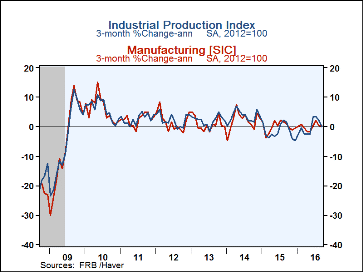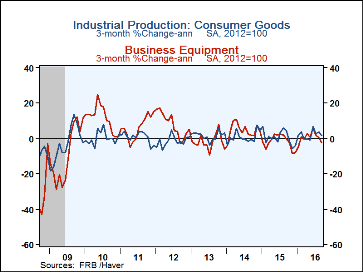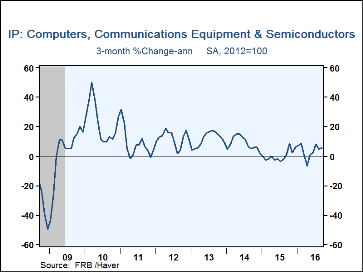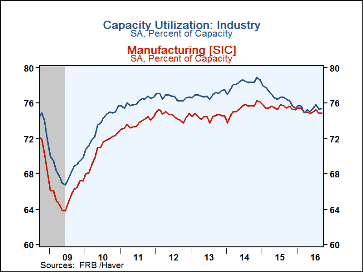 Global| Oct 17 2016
Global| Oct 17 2016U.S. Industrial Production Edges Up as Factory Output Firms
by:Tom Moeller
|in:Economy in Brief
Summary
Industrial output nudged 0.1% higher (-1.0% y/y) during September following a 0.5% August decline, revised from -0.4%. The increase matched expectations in the Action Economics Forecast Survey. Factory sector production increased 0.2% [...]
Industrial output nudged 0.1% higher (-1.0% y/y) during September following a 0.5% August decline, revised from -0.4%. The increase matched expectations in the Action Economics Forecast Survey.
Factory sector production increased 0.2% last month following a 0.5% decline, revised from -0.4%. Despite the gain, manufacturing output was unchanged y/y. Consumer goods production rose 0.2% (0.9% y/y) and reversed the prior month's decline. In the durable goods sector, furniture & appliance production rose 0.3% (-2.3% y/y) following declines in six of the prior seven months. Motor vehicle & parts production gained 0.2% (5.0% y/y). Appliance & electrical equipment production edged 0.1% higher (0.8% y/y) after two months of decline. In the nondurable goods area, apparel output increased 0.9% (-8.1% y/y), and chemical production rose 0.5% (0.7% y/y). Paper output improved 0.1% (-2.5% y/y). In the capital goods sector, production eased 0.2% (-1.5% y/y) after a 0.5% drop. Transit equipment production fell 0.6% (-4.2% y/y), and information processing equipment remained unchanged (+3.3% y/y). Construction supplies production gained 0.8% (1.3% y/y).
In the materials sector, a 0.2% output decline (-2.3% y/y) reflected a 0.3% fall (-0.8% y/y) in durables and a 0.5% rise 0.1% y/y) in nondurables.
Utilities output fell 1.0% (-0.5% y/y) while mining output improved 0.4% (-9.4% y/y).
In the special industrial output groupings, computers, communications equipment & semiconductor output rose 0.6% (3.8% y/y). Communications equipment output increased 0.2% (8.0% y/y). Overall factory sector production excluding both the high-tech and automotive sectors rose 0.2% (-0.6% y/y) following a 0.7% decline.
Capacity utilization improved to 75.4%. It has been moving sideways this year following a decline from the 2014 peak of 78.9%. Factory sector utilization also rose to 74.9%, but remained below the 2014 peak of 76.3%.
Industrial production and capacity data are included in Haver's USECON database, with additional detail in the IP database. The expectations figure is in the AS1REPNA database.
Macroeconomic Research After the Crisis from Fed Chair Janet L. Yellen is available here.
| Industrial Production (SA, % Change) | Sep | Aug | Jul | Sep Y/Y | 2015 | 2014 | 2013 |
|---|---|---|---|---|---|---|---|
| Total Output | 0.1 | -0.5 | 0.5 | -1.0 | 0.3 | 2.9 | 1.9 |
| Manufacturing | 0.2 | -0.5 | 0.4 | 0.0 | 0.8 | 1.3 | 0.9 |
| Consumer Goods | 0.2 | -0.2 | 0.4 | 0.9 | 1.4 | 0.7 | 0.7 |
| Business Equipment | -0.2 | -0.5 | 0.1 | -1.5 | 0.7 | 2.4 | -0.2 |
| Construction Supplies | 0.8 | -1.4 | 1.0 | 1.3 | 1.5 | 3.7 | 3.0 |
| Materials | -0.2 | -0.6 | 0.6 | -2.3 | 0.5 | 4.7 | 3.3 |
| Utilities | -1.0 | -0.3 | 0.3 | -0.5 | -0.7 | 1.3 | 2.3 |
| Mining | 0.4 | -1.0 | 1.1 | -9.4 | -1.8 | 11.0 | 6.5 |
| Capacity Utilization (%) | 75.4 | 75.3 | 75.8 | 76.4 | 76.7 | 78.2 | 76.9 |
| Manufacturing | 74.9 | 74.8 | 75.5 | 75.5 | 75.5 | 75.4 | 74.5 |
Tom Moeller
AuthorMore in Author Profile »Prior to joining Haver Analytics in 2000, Mr. Moeller worked as the Economist at Chancellor Capital Management from 1985 to 1999. There, he developed comprehensive economic forecasts and interpreted economic data for equity and fixed income portfolio managers. Also at Chancellor, Mr. Moeller worked as an equity analyst and was responsible for researching and rating companies in the economically sensitive automobile and housing industries for investment in Chancellor’s equity portfolio. Prior to joining Chancellor, Mr. Moeller was an Economist at Citibank from 1979 to 1984. He also analyzed pricing behavior in the metals industry for the Council on Wage and Price Stability in Washington, D.C. In 1999, Mr. Moeller received the award for most accurate forecast from the Forecasters' Club of New York. From 1990 to 1992 he was President of the New York Association for Business Economists. Mr. Moeller earned an M.B.A. in Finance from Fordham University, where he graduated in 1987. He holds a Bachelor of Arts in Economics from George Washington University.










